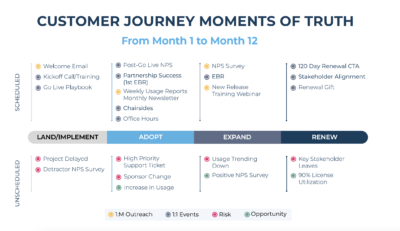“What is ROI? How do you measure it? Is it different for every customer?”
These are just a few of the questions that customer success (CS) experts explored in a recent episode of CS Essentials by Gainsight: Talking About ROI, a Success League Radio production. The podcast is hosted by Kristen Hayer, Founder and CEO of the Success League, a consulting and training firm focused on developing customer success programs that drive revenue. This series is also hosted by Tim Van Lew, Director of Customer Success Strategy at Gainsight.
Hayer and Van Lew sat down with Chris Bohle, Director of Value Consulting and Strategy at Gainsight, to talk about all things ROI—specifically how customers see a return on their investment in your solution. Here are some highlights from their conversation that can help guide your customer value strategy going into the recession.
Start with six common business challenges
The Gainsight team identified six pain points through research and conversations with industry leaders:
- Visibility
- Adoption
- Retention
- Scale
- Customer Experience
- Expansion
These six challenges are a framework for not only solving customer pain points, but also leading the customer to value as quickly as possible. Bohle says, “where there are pain points, there is the potential for value that we want to try to identify and define.”
After identifying the trapped value, Chris’s team will craft a business case to realize that value through deliberate processes and strategies, while ensuring a cyclical review process with stakeholders to account for changes in business needs and the market. This is Gainsight’s operationalizing outcomes framework. Each of the pain points has specific outcomes helping guide the customer to value
According to Van Lew, this cyclical nature of transforming customer pain points into successful outcomes is key to proving ROI. He says, at its core value, ROI is about “helping a customer either decrease costs or improve performance. That’s the groundwork of it.” From there, “CS comes into play … validating those objectives [and] the strategy that they want to implement.”
Van Lew continues that CS is charged with, “verifying that those [objectives] are actually being implemented and tracked and measured—and then you’re going on to the next one.” He says, “you’re constantly in that cyclical motion. It’s when you don’t get in that cyclical motion that it becomes stale and your executive buyers don’t actually see that value.”
Value engineering through the lifecycle
The cyclical value framework “points to the importance of understanding how customer value is presented and discussed at different stages in the customer lifecycle, all the way from marketing through customer success,” says Hayer.
At Gainsight, we’ve created a framework that identifies key moments along that journey, where the entire enterprise can get involved in engineering value for customers, from landing an account through to renewal and expansion.

On the topic of value engineering through this lifecycle, Bohle reflects that it’s all about working together, across teams: “ As you evolve into a true value engineering practice, it starts to become much more cross-functional.”
Bohle continues, “the concept of value engineering is a little bit more broadly infused across Sales, Services, Support, and Success. And so you’re really getting buy-in from the entire organization [regarding] how we need to be talking about value in each one of those stages. This is how we need to be talking about it in Sales. This is how we need to be talking about it in Services. And this is how we need to be talking about it in Customer Success.”
Cross-functional ROI Success Plans
Something a lot of organizations struggle with is working cross-functionally once a sale is made. That handoff between Sales and Customer Success must be smooth and CSMs must be armed with what they need to make the customer wildly successful. A great way to do that is collaboratively creating an ROI Success Plan.
Bohle says, “an ROI Success Plan can be really, really helpful because you can have different objectives that live within that Success Plan. And as you achieve those and demonstrate value for each one of those objectives, you can kind of cross that off the list and say, okay, we achieved this, we achieved your original goal. Now let’s talk about what we want to achieve next. Let’s come up with the game plan for the next three to six months and figure out how that value roadmap needs to evolve.”
Now more than ever, it’s critical to do more with your current customers and help them realize more value with your solution. In Bohle’s words, “there’s always going to be certain macro things that may impact a company’s ability to see value … you have to be able to step back and work with your champion, your stakeholder, and figure out how to get them back on track.”
To learn more about how to get your customers on track to value with a savvy CS operation, check out our ebook, Smarter Not Harder: How to Launch Customer Success From Scratch.

